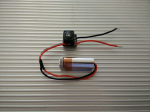rhd
0
- Joined
- Dec 7, 2010
- Messages
- 8,469
- Points
- 0
471nm 1.5W+ Nichia NDB7675 in module w/ Custom "Edge Driver" @ 2.7A & G9 Lens
471nm 1.5W+ Nichia NDB7675 in module w/ Custom "Edge Driver" @ 2.7A & G9 Lens
This is a Nichia NDB7675, pushed to (and spectro'd at) 471.5nm, with a pre-soldered "Edge Driver" and a G9 single element lens. Output power is 1.5W+ @ 471nm.
The "Edge Driver" is a buck designed for safer cleaner wavelength pushing on Nichia 462nm diodes. It's assembled by hand, uses pricey components, and each driver takes about an hour to make, but it's meant to be the most efficient, clean, and stable 2.7A buck for pushing these new 462s closer to the edge of their "true death" curve (which is at 2.9 to 3.0 A), without concern for ripple pushing it over the edge. Heatsinked, this driver will stay locked on 2.7A, with little if any meaningful fluctuation. It can also run unheatsinked for 60 seconds, staying stable +/- 100mA. However, I strongly recommend heatsinking the driver to the host, and it has a large copper pad on the bottom for incredibly simple heatsinking, or you can even heatsink the inductor instead.


471nm 1.5W+ Nichia NDB7675 in module w/ Custom "Edge Driver" @ 2.7A & G9 Lens
This is a Nichia NDB7675, pushed to (and spectro'd at) 471.5nm, with a pre-soldered "Edge Driver" and a G9 single element lens. Output power is 1.5W+ @ 471nm.
The "Edge Driver" is a buck designed for safer cleaner wavelength pushing on Nichia 462nm diodes. It's assembled by hand, uses pricey components, and each driver takes about an hour to make, but it's meant to be the most efficient, clean, and stable 2.7A buck for pushing these new 462s closer to the edge of their "true death" curve (which is at 2.9 to 3.0 A), without concern for ripple pushing it over the edge. Heatsinked, this driver will stay locked on 2.7A, with little if any meaningful fluctuation. It can also run unheatsinked for 60 seconds, staying stable +/- 100mA. However, I strongly recommend heatsinking the driver to the host, and it has a large copper pad on the bottom for incredibly simple heatsinking, or you can even heatsink the inductor instead.
Attachments
Last edited:





